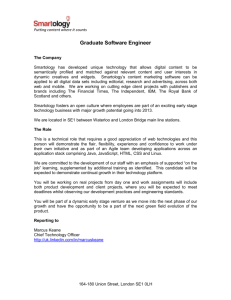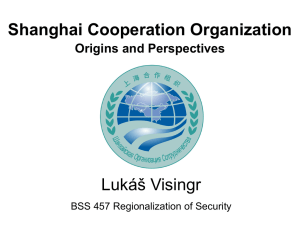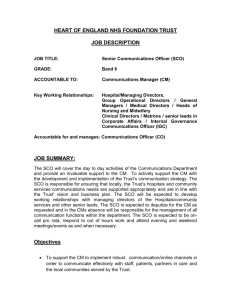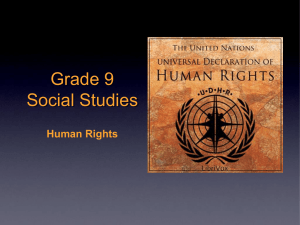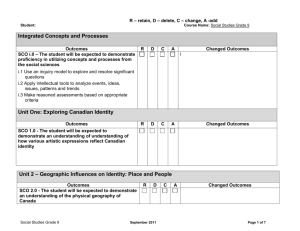Document 10466982
advertisement
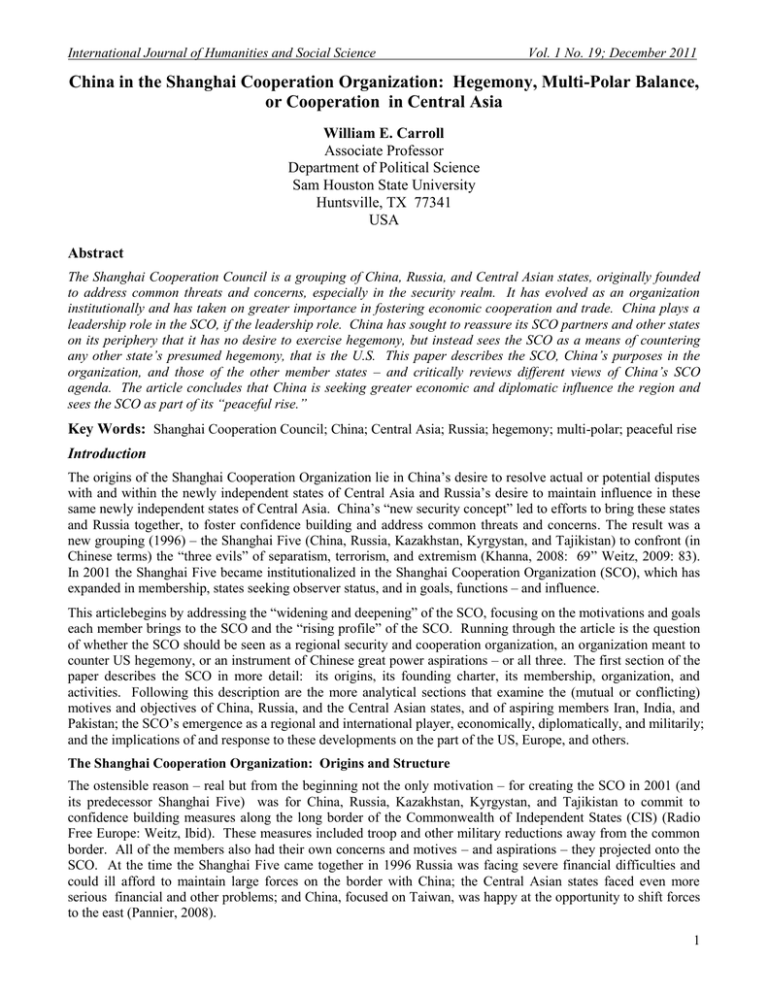
International Journal of Humanities and Social Science Vol. 1 No. 19; December 2011 China in the Shanghai Cooperation Organization: Hegemony, Multi-Polar Balance, or Cooperation in Central Asia William E. Carroll Associate Professor Department of Political Science Sam Houston State University Huntsville, TX 77341 USA Abstract The Shanghai Cooperation Council is a grouping of China, Russia, and Central Asian states, originally founded to address common threats and concerns, especially in the security realm. It has evolved as an organization institutionally and has taken on greater importance in fostering economic cooperation and trade. China plays a leadership role in the SCO, if the leadership role. China has sought to reassure its SCO partners and other states on its periphery that it has no desire to exercise hegemony, but instead sees the SCO as a means of countering any other state’s presumed hegemony, that is the U.S. This paper describes the SCO, China’s purposes in the organization, and those of the other member states – and critically reviews different views of China’s SCO agenda. The article concludes that China is seeking greater economic and diplomatic influence the region and sees the SCO as part of its “peaceful rise.” Key Words: Shanghai Cooperation Council; China; Central Asia; Russia; hegemony; multi-polar; peaceful rise Introduction The origins of the Shanghai Cooperation Organization lie in China‟s desire to resolve actual or potential disputes with and within the newly independent states of Central Asia and Russia‟s desire to maintain influence in these same newly independent states of Central Asia. China‟s “new security concept” led to efforts to bring these states and Russia together, to foster confidence building and address common threats and concerns. The result was a new grouping (1996) – the Shanghai Five (China, Russia, Kazakhstan, Kyrgystan, and Tajikistan) to confront (in Chinese terms) the “three evils” of separatism, terrorism, and extremism (Khanna, 2008: 69” Weitz, 2009: 83). In 2001 the Shanghai Five became institutionalized in the Shanghai Cooperation Organization (SCO), which has expanded in membership, states seeking observer status, and in goals, functions – and influence. This articlebegins by addressing the “widening and deepening” of the SCO, focusing on the motivations and goals each member brings to the SCO and the “rising profile” of the SCO. Running through the article is the question of whether the SCO should be seen as a regional security and cooperation organization, an organization meant to counter US hegemony, or an instrument of Chinese great power aspirations – or all three. The first section of the paper describes the SCO in more detail: its origins, its founding charter, its membership, organization, and activities. Following this description are the more analytical sections that examine the (mutual or conflicting) motives and objectives of China, Russia, and the Central Asian states, and of aspiring members Iran, India, and Pakistan; the SCO‟s emergence as a regional and international player, economically, diplomatically, and militarily; and the implications of and response to these developments on the part of the US, Europe, and others. The Shanghai Cooperation Organization: Origins and Structure The ostensible reason – real but from the beginning not the only motivation – for creating the SCO in 2001 (and its predecessor Shanghai Five) was for China, Russia, Kazakhstan, Kyrgystan, and Tajikistan to commit to confidence building measures along the long border of the Commonwealth of Independent States (CIS) (Radio Free Europe: Weitz, Ibid). These measures included troop and other military reductions away from the common border. All of the members also had their own concerns and motives – and aspirations – they projected onto the SCO. At the time the Shanghai Five came together in 1996 Russia was facing severe financial difficulties and could ill afford to maintain large forces on the border with China; the Central Asian states faced even more serious financial and other problems; and China, focused on Taiwan, was happy at the opportunity to shift forces to the east (Pannier, 2008). 1 © Centre for Promoting Ideas, USA www.ijhssnet.com The stated objective of the SCO as enumerated in the organization‟s Declaration on June 1, 2001, encompassed the two formal agreements that implemented the confidence building measures meant to safeguard peace, security, and stability regionally and globally (Xinhua, June 15, 2001, reported in BBC Worldwide Monitoring). By 2001 Chinese concerns about the Uighur Muslim minority in Xinjiang had grown, mirroring Russian troubles in Chechnya and Central Asian states‟ own relations with “restive Islamic communities (Pannier, Ibid). Uzbekistan joining the SCO as the sixth member reflected its government‟s worries about the Islamic Movement of Uzbekistan, whose stated goal is to overthrow the Uzbek government and replace it with an Islamic caliphate (Ibid). From the beginning however additional areas of cooperation were agreed: “ The objectives of the Shanghai Cooperation Organization are: strengthening mutual trust among member countries; promoting effective cooperation between member countries in political, economic, scientific-technical, and educational spheres and in energy, communications, environmental protection, and other areas; joint efforts to maintain regional peace, security, and stability; and building a democratic, just, and rational international order. The “Shanghai Spirit” [is] marked by mutual trust, reciprocity, equality, consultation, respect of the diversity of cultures, and the desire to develop jointly…Member countries … will strictly abide by the goals and principles of the Charter of the United Nations, the principles of mutual respect of independence, sovereignty and territorial integrity, equality and mutual benefit, the solution of all issues through mutual consultations… they will not use threat or force against each other…they will not seek to achieve unilateral military superiority in contiguous areas. The Shanghai Cooperation Organization is not an alliance directed against any other states and regions…” (Ibid; Ministry of Foreign Affairs of the Russian Federation, June 20, 2001). The Shanghai Convention signed simultaneously with the Declaration on the establishment of the SCO specifically addressed the goals of combating terrorism, separatism, and extremism (Keeton, 2008). The SCO‟s internal policy is based on the following principles: mutual trust and benefit; equal rights, consultation, respect for diversity of cultures, aspiring to common development, and in its external relations: non-alignment, nontargeting of anyone, and openness (Ibid). Its principles for internal policy are reflected in the SCO‟s organizational structure (Keeton, 2008).The Heads of State Council is the highest decision making body in the SCO, while the Heads of Government Council is the forum for discussing strategies for cooperation and priority directions within the Organization‟s framework and adopts the SCO‟s annual budget (Ibid). Both these bodies meet once a year; in addition there are regular meetings at the ministerial level, speakers of parliaments, and Courts/Procurators. There are two permanent bodies, the Secretariat in Beijing and the Regional Antiterrorist Structure (RATS) in Tashkent (the latter highlights the centrality of this issue for the member founders) (Chin-hao Huang, 2006: 18). The Shanghai Cooperation Organization: Widening and Deepening: Differing Motives and Objectives The issue of SCO expansion is best understood in the context of geopolitical factors and the different – or congruent – motives of its members. Of course the same can be said regarding how the SCO‟s mission may expand and whether the Organization may be strengthened institutionally. Therefore before addressing these questions, or rather trying to answer them while examining member states‟ motives, the latter are presented next, beginning with China and Russia. China‟s Objectives: These are considered both vis-à-vis the SCO and China‟s partners in the SCO.In a 2004 statement President Hu Jintao reiterated the need for the SCO to combat the “three evils” of terrorism, extremism and separatism, along with drug trafficking and international crime, the latter two included in the Charter (Uzbek Radio, BBC, June 17, 2004). He said as well that “the most important thing in the economic field is implementing a multilateral programme on economic cooperation” to be accomplished by five special working groups to be launched (Ibid). In the leadup to the 2005 summit in Astana, Kazakhstan Russia and China further elaborated their strategic aims (Declaration on the World Order in the 21st Century). Following a meeting of the two in Moscow, Hu and then Russian President Putin issued a joint declaration on “world order” rejecting efforts by any powers (read U.S.) to achieve a “monopoly in world affairs,” divide the world into “leaders and followers,‟” and “impose models of social development” on other countries (PINR, 2005). Areas of Sino-Russian disagreement will be addressed in a later section. China‟s insistence on a “multi-polar world” and its obvious challenge to the US is stated unambiguously in a 2002 Defense White Paper, which identified US efforts to strengthen military alliances in Asia as one of the “factors of instability” in the region (Bergsten, et al, 2006: 126). 2 International Journal of Humanities and Social Science Vol. 1 No. 19; December 2011 China even holds the US responsible for the “color” revolutions in Ukraine and Central Asia (Rozoff, 2009). Since the 1990s China has promoted its “New Security Concept,” the essence of which is “common security through mutually beneficial cooperation” (au.china-embassy…2003). Central to this policy is the SCO as a vehicle for attacking the “three evils” and for developing “strategic partnerships” as alternatives to US hegemony (Ibid). Complementing the SCO China also relies on its participation in the ASEAN + 3 forum that also includes Japan and South Korea, and the East Asia Summit - all largely defensive (Ibid: 14). Supporting an SCO taking on more responsibilities, becoming a more comprehensive organization, reflects China‟s goal of building “comprehensive strategic partnerships” (Shambaugh, 2005: 30-31). China is even proposing a free trade zone encompassing the SCO area (as proposed by Prime Minister WenJiabao in 2003). China is facilitating expanded trade opportunities by massive highway construction along the “Silk Road” (Khanna: 96-97). Russia‟s Objectives: “Translated into geostrategic terms, the SCO arises from a confluence of interests among the major power centers of China and Russia, and the former Soviet republics of Central Asia… which pursues a foreign policy of studied neutrality and isolation” (PINR, Ibid). How neutral and isolated is a matter of debate, considered below. Nevertheless, as indicated above, China and Russia shared the strategic aim of curbing (containing!) US influence in Central Asia, and sought to establish a joint sphere of influence in the region (Ibid). It‟s important to emphasize Russia‟s desire to reestablish its prestige and influence in Central Asia (“Russian Foreign Policy Concept). Russia is also deeply interested in using the SCO as a means of furthering the economic development of Siberia and the Far East (Ibid). Whether there is incipient rivalry between the two major powers in the SCO is a critical matter. From the beginning China viewed the SCO as a channel for efforts to resolve disputes and promote ties with historic rivals Russia and India (Bergsten, et al: 128). The latter two shared China‟s calls for a multi-polar world – particularly Putin and Russia (India defines multi-polar differently from the other two). Both Russia and China are alert to US efforts to build or strengthen military alliances on their respective doorsteps (Ibid: 134-135). Indeed perceived U.S. unilateralism has pushed Russia and China closer (Yubin, 2005: 234). Thus Russia‟s and China‟s overlapping interests portend the durability of the SCO (Ibid: 236). In 2007 SCO members, Russia, China, and four Central Asian states, conducted the largest joint anti-terrorism exercises thus far, involving 6,000 troops, in “Peace Mission 2007” near Russia‟s Ural Mountains (Bayron, 2007). On the other hand Russia is the driving force behind an anti-US agenda for the SCO, while China is not as prepared as Russia seems to be to see relations with the U.S. further deteriorate (Ibid). Tajikistan and Uzbekistan share China‟s concerns, despite Uzbekistan‟s ejection of US forces. (Currently the US and Uzbekistan are negotiating a new base deal). Russia and China also have different views on SCO expansion, particularly on Iran‟s application to join. Central Asia: Kazakhstan, Kyrgystan, Tajikistan, and Uzbekistan are of course co-founders of the SCO with Russia and China, while the first three were part of the original Shanghai Five. All four joined with Russia and China in drafting the founding Declaration of the SCO which set out the official purposes of the “alliance:” security, economic development, expanding trade, and cultural exchanges (Weinstein, 2005: 1). That is to say, the Central Asian states were no less interested in achieving these goals through the SCO than Russia and China. If anything they each had greater concerns with external security, internal threats to stability, and terrorist threats than their giant partners (Ibid; Radio Free Europe, 2006: 2). China‟s and Russia‟s concerns, as seen, were that these threats might spill over into their own sensitive areas, in China‟s case its huge and restive “west” (Xinjiang) and Russia its borders with Central Asia. Central Asia is also central to Russia and China who have sought, with different degrees of determination, to limit U.S. influence in the region and establish and maintain a “joint sphere of influence” there (Weinstein, Ibid). The concerns of the Central Asian states with security produced in the first years of the SCO a reluctance to give up their “multi-directional” policies of playing off the U.S. and the West against their larger partners (Ibid). However as a result of successful regime changes in Georgia, Ukraine, and Kyrgystan, which exposed their own vulnerability, and coming to a realization that the U.S. and Europe would press for Western-oriented, marketbased systems to replace their corrupt or authoritarian systems, the Central Asians moved closer to Russia and China in the SCO. Consequently the prospect for the SCO to act as a politically effective alliance was enhanced (Ibid; Goldhorn, 2005). Leading and manifesting this transformation was Uzbekistan and its president Islam Karimov, who rejected Western criticisms of the bloody crackdown of protesters in Andijon in 2005, and “sought shelter within the SCO” (Radio Free Europe, Ibid). The SCO also served as a forum for Karimovto demand the withdrawal of US forces form Khanabad air base (Ibid). 3 © Centre for Promoting Ideas, USA www.ijhssnet.com Having said all this, renewed fears of the growing threat posed by the Taliban and al Qaeda in Afghanistan, while highlighting and heightening the security dimension of the SCO could also lead to greater cooperation between the SCO and NATO in Afghanistan (de Haas, 2008: 28). Expansion? Iran, Pakistan, and India: These three (along with Mongolia) have observer status in the SCO, with Iran pressing strongly for full membership. Russia is pushing for membership for Iran, not unconnected to Russia‟s eagerness to push the SCO toward a NATO-like alliance (Global Security, 2007). Russia infact has threatened to block any expansion of SCO membership unless Iran is included (Goldkorn, 2005). Russia – Putin – cannot be unaware that Iranian membership would strengthen any perception that the SCO is an anti-Western grouping. On the other hand, China emphasizes economic priorities, in contrast to Russia‟s desire to have the SCO become more of a security organization; nor as stated earlier does China share the same apparent willingness as Russia to see relations with the U.S. deteriorate. Iran‟s distrust of US actions and motives reflect Russia‟s: they believe the U.S. is seeking to use Azerbaijan to counterbalance Iran and are upset at the US helping Kazakhstan build its navy (a perceived threat to Iranian oil stakes in the Caspian Sea) (Vail, 2007: 4). In fact Russia is taking the leadin developing an alliance of Caspian littoral states, although a summit in Tehran in October, 2007 was “clouded‟ by a worsening of the US – Iranian confrontation over Iran‟s suspected nuclear ambitions (Ibid). Iran‟s push to be accorded full SCO membership is driven by a desire to avoid international isolation over its nuclear program and gain political cover in its confrontation with the US and the UN Security Council (Goncharev, 2008). China is thus far the strongest opponent of Iranian membership – while recognizing Iran‟s economic importance: Iran is already a key player in the region, involved in the construction of tunnels and rail lines that will link Tajikistan, Afghanistan, and Iran. India and Pakistan were granted observer status in 2005 (along with Iran and Mongolia). Possible membership for India and Pakistan is complicated by differences between Russia and China. China has insisted that the two be admitted simultaneously, while both Russia and India criticize any such linkage (Goldkorn, Ibid). There are multiple geo-political and geo-economic realities driving Pakistan‟s desire to join (Zeb, 2006: 52) An example of the former is using the SCO to reduce US leverage on Pakistan (Goldkorn, Ibid).Increasing violence in Afghanistan has only increased Pakistan‟s desire to have good relations with the Central Asian states, although this effort is complicated by Pakistan‟s perceived support for the Taliban (despite Pakistan‟s apparent break with the Taliban after 9-11 and the recent military drives against the Taliban in Pakistan). Pakistan is home to a number of extremist groups and the Central Asian states want to see Islamabad do more to counter them (Zeb: 59). Pakistan‟s case for membership stresses “the role [it] can play of a trade-economic corridor on the SCO territory and will be committed to the organization‟s charter … Pakistan provides the natural link between the SCO states to connect the Eurasian heartland with the Arabian Sea and South Asia” (Ibid: 56-57). On India‟s side, working closely with China in the SCO may facilitate resolution of longstanding border disputes with China, in Aksai Chin and Arunachal Pradesh (Bergsten, et al, 2006: 121). India shares China‟s reluctance to see the SCO develop further into a military bloc (Antonenko, n.d.: 4). However, both countries have taken their bilateral security ties to a new level, with joint military exercises held in 2007 (Vail, 2008: 4). In a joint statement in 2007WenJiabao and Monmohan Singh expressed their commitment to moving beyond bilateral matters, to encompass issues of “peace, stability, and prosperity in the region and the world beyond” (Ibid). If the political impediments to expansion are resolved their joint commitments could be pursued within the SCO. Moreover, if Pakistan and India were both members of the SCO then, along with the ASEAN Regional Forum, the SCO would be the second security forum that brought them together (Zeb, Ibid: 56). US and European Perceptions and Responses Are fears that the SCO is a Chinese-led anti-US axis limited to “anti-China” “fanatics” in the U.S.? (Sinomania: 2008). Should reaffirmations by the Chinese that the SCO is not a departure from China‟s adherence to the “path of peaceful development” and wants only to build a secure and prosperous region be relied on? (Hu Jintao reported in China Daily: 2006). As described earlier China has been reluctant to see the SCO turned into a NATO-like military alliance, which, again, seems to be more of a Russian aspiration. Joint military exercises have been limited in scope to anti-terrorist operations involving no more than 4,000 troops and at this stage are largely symbolic. Kazakhstan blocked the movement of Chinese troops while Russia complained that China wanted to bring too much military equipment onto its territory (Chang, 2007). Whether the SCO‟s goals are consonant with US goals and objectives, and presence in Central Asia, or instead are seen as potential challenges to US objectives are core questions for the U.S. Thesequestions are directly addressed by the Deputy Secretary of State for South and Central Asia in comments he made at the Nixon Center in 2007 (Feigenbaum, 2007). 4 International Journal of Humanities and Social Science Vol. 1 No. 19; December 2011 It would appear that for US policy makers that the SCO is still rather an unknown: “To be candid we didn‟t fully understand what the Shanghai Cooperation Organization does.” Granted, this is said in the context of questioning if the SCO goes beyond the rhetoric of promoting cooperation and integration in Central Asia. The Secretary did not think so; the SCO has an ambitious range of goals but it is difficult to identify any of which has not been achieved by bilateral or non-SCO agreements. The US‟ssecurity assistanceprograms and growing US investment in all five of the Central Asian countries are touted. On the other hand he calls on Russia and China to respect US interests, presence, and role in the region. A clearly stated assumption is that the Central Asian states will continue to look to the US as well as Russia and China for their security and will not allow themselves to be turned into pawns of the two SCO powers. At the same time however the Secretary concedes that when there is a preponderant power there is a tendency for others to join together to achieve balance. This, as was seen earlier, was certainly one of the purposes SCO members brought to the Organization – once the Shanghai Five had resolved territorial issues. While acknowledging the need for the U.S. to reassure others about our intentions in the region, the U.S. as well needs reassurances. According to Secretary Feigenbaum if each of the members of the SCO individually shares an interest with the U.S., then all members should collectively share that interest. The “logic” here perhaps exaggerates the degree of shared interests, and whether SCO members (specifically the Central Asian members) prefer to use the SCO to complement or even to replace dependence on the US for their security or to achieve their other goals. The clearest example of a Central Asian member using the SCO to „„escape‟ US pressure was Uzbekistan, when it demanded that the U.S. withdraw its forces from bases in the country and as a forum for rejecting US and Western criticisms of the government‟s violent crackdown on protesters (Radio Free Europe, 2006). US concerns would certainly intensify if Iran were granted full membership – and the USsharply criticized the extending an invitation to President Ahmadinejad to attend the five year anniversary of the SCO in 2006 (Goncharev, 2008). Europe: In a policy brief published by the Centre for European Reform, Oksana Antonenko makes the case for Western, specifically the European Union, engagement with the SCO (Antonenko, 2007). Among the objectives the EU could fulfill through dialogue with the SCO are “deepening ties with Russia and China; promoting economic development in Central Asia; tackling soft security threats that emanate from the region (such as drug trafficking and migration); and enhancing its energy security” (Ibid: 6). Another issue of mutual concern, to both the EU and Central Asian governments, is counter-terrorism, including terrorist groups such as Hizbut-Tahrir and networks linked to the Taliban. There is already formal contact between the SCO and the EU: EU High Representative Solana met with the SCO‟s then-Secretary General Zhang in 2004. The new EU Special Representative (EUSR) for Central Asia may also facilitate enhanced ties to the SCO; Kyrgystan‟s President declared his support for initiatives to invigorate closer EU-SCO dialogue (Ibid: 6-7). The “only” constraint on closer EU-SCO ties is that some European governments may view the SCO as anti-Western and many criticize its members for human rights abuses. Antonenko is more sanguine however, pointingto Krygyzstan and Kazakhstan‟s membership in the SCO (both of whom maintain close ties to the EU, NATO, and the US); admission of India and Mongolia as observers (which, as these two are partners with the US, belies the antiWestern image of the SCO); and the resemblance of the SCO to ASEAN in its adherence to the principle of noninterference (although this mutes criticism of non-democratic member governments, as is the case with ASEAN. The Shanghai Cooperation Organization: Collective Security, Balancing, or Instrument of Hegemony Several events have signified the SCO‟s “rising economic, political and military profile” (Vail: 2). One might say these events not only signified an emergent SCO and were factors behind its creation and institutionalization: the uncertainties regarding post-Taliban Afghanistan; a larger US military presence in Central Asia; the SCO‟s own rapid expansion; the Caspian Sea Nations Summit; and „Peace Mission 2007,‟ the joint military exercises discussed earlier. Vail points to the SCO‟s development of its own Afghan policy, including the founding of the Afghanistan Contact Group (ACG) to strengthen the relationship between the SCO and the Afghan government of Hamid Karzai (Ibid: 3). Moreover Afghanistan is a prospective member of the SCO. From the U.S. and NATO viewpoints the military dimension of an emerging SCO is a paramount concern. As the SCO strengthens (if it does) its links to the Russian dominated Collective Security Treaty Organization (CSTO), which is seen by western observers as a Eurasian military pact, concerns only grow; all SCO members except China are also members of the CSTO. It remains to be seen what comes of any CSTO-SCO cooperation in the future; speculating one might see CSTO-SCO ties as China‟s entrée into what comes of the relationship, shaping or inhibiting developments it may deem unwise or provocative. 5 © Centre for Promoting Ideas, USA www.ijhssnet.com In fact China‟s position is that the CSTO is primarily a political-military organization, while the SCO should remain a political-economic organization (de Haas, 2006: 22). China‟s decision to delay a Memorandum of Understanding (MoU), which would have deepened relations between the SCO and the CSTO, is to be seen in this light. China ultimately overcame its hesitations and the MoU was agreed in 2007. It establishes the following “fields of cooperation:” ensuring regional and international security and stability; counter-terrorism; fighting drug and arms trafficking; counteraction against transnational organized crime; and other areas of mutual concern (Ibid: 23). One notes that security and stability, combating terrorism and cross-border crime, are original goals of the SCO. Joint action towards Afghanistan is proposed by the CSTO and CSTO observers who were present (but did not participate) in the Peace Mission 2007 joint military exercises. An important difference to note between NATO and the SCO is that NATO is aimed at external threats, whereas the SCO is concerned with security within the territory of it members (Ibid: 30). A second view suggests “the SCO will gradually lose its cohesion along with the resurgence of Russia” (Chang, 2007). On the one hand China is arguably big enough to balance Russia. Rieber however suggests that now Russian influence is predominant in Kazakhstan and Tajikistan, the U.S. in Azerbaijan and Uzbekistan, while Kyrgystan is open to influence by both powers. As we‟ve seen U.S. influence in Uzbekistan was at least for the time lost when Karamov ordered the U.S. from its bases in the country. Karamov was in turn supported by Russia and China within the SCO (Goldhorn, 2005). On the other hand Tajikistan‟s decision to permit Russia to establish a military base in the country has generated controversy in both Tajikistan and Uzbekistan (Farazh, August 20, 2009). There are those who see the SCO as the, or an, instrument of Chinese hegemony in Central Asia in pursuit of a broader goal of displacing the U.S. as the regional, even global superpower (Kaplaan, 2010). This view was seen to be at least in need of moderation, in light of China‟s stated agenda and goals for the SCO – and China‟s caution in seeing the SCO as more than a forum/organization for pursuing economic opportunities and maintaining regional security. There is another view then which does not envision the SCO as a NATO-like Warsaw Pact military organization or likely to fall apart): that the SCO will continue to widen and deepen while exercising caution in the militarysecurity area. Perhaps the SCO will prove mutable or will appear to be different things depending on which area of cooperation is emphasized or who is viewing it and from which vantage point. As RizwanZeb notes the SCO has been described variously, especially by American observers, “as an enigma, a security organization, a regional forum, an anti-terrorism coalition, and as a Russian and Chinese led alliance created to counter U.S. hegemony” (Zeb, 2006: 51). It seems quite plausible to maintain that the SCO is all of the above. Central Asia certainly is the cockpit of great power concerns and actions: after 9-11 the US realized that the Central Asian republics are vital in the war against terrorism and viewed the establishment of military bases in the region as a necessity. Russia and China both may have understood the necessity of these bases from the American viewpoint, yet both looked on with increasing suspicions (Ibid: 53-54). The Chinese fear that an American military presence in Central Asia is a continuation of U.S. “encirclement” of China (Ibid). The Russians too (Russian interventions in the Caucasus are further illustration) view Central Asia (former Soviet republics) as Russia‟s “near abroad” and so fears and resents the U.S.‟s growing presence (Ibid). None of this contradicts the mutual interests of the U.S. and Russia in the stability of the region (Chin HaoYuang, 2006: 15). It does however complicate three-way, or four-way, relations relative to the region. Finally, is the SCO an instrument of Chinese hegemony? Is it a vehicle for Russian hegemony in Central Asia? As we‟ve seen Russia has been keen to see closer integration of the SCO with the CSTO.China denies time and again any such intentions. As seen it‟s been China that has pushed economic development and trade as the new priorities for the SCO. Some observers may see this as the means and end of Chinese hegemony: China certainly has deployed aid, investment, and infrastructure projects that further its economic expansion (peaceful rise) (Channa, Ibid). At the least China presents an alternative model of development, market-based authoritarianism, more successful that Russia‟s model [whatever it is], a model that may be attractive to all or some of the Central Asian countries. Whether this is a conscious Chinese objective is another thing. Ideological proselytizing though is secondary (if it ranks at all) to China‟s interests in countering the “three evils‟ and furthering economic cooperation. For China as well as for Russia and the Central Asian states, not excluding India, Pakistan, Iran, even the US the SCO is a prism through which to peer into, to view, to analyze, the foreign policy goals and objectives of these states individually and, for members, collectively. 6 International Journal of Humanities and Social Science Vol. 1 No. 19; December 2011 Conclusion What‟s learned from an analysis of China and Russia in the SCO? A key goal of both Russia and China is to counterbalance U.S. “hegemony.” This has been partly successful, although China‟s and Russia‟s Central Asian partners do not wish to cut the U.S. out entirely. China‟s “partners” in ASEAN are of the same mind, not wishing to marginalize the US – for security reasons and to balance China‟s growing economic competitiveness in their own and world markets (Sutter, 2008). In fact China‟s new security policy was initially pursued in Southeast Asia – building formal vehicles for China‟s participation in ASEAN , for economic and diplomatic interests, and again to mitigate territorial disputes and for confidence building (Ibid). Their other vital interest is security, avoiding potential regional conflict and containing any terrorist threat. For China this means stability, the latter achieved through regional fora for cooperation. China‟s economic interests, at least as important as security, are also pursued through greater regional cooperation and trade. As we‟ve seen Russia is no less interested in the economic potential of the SCO. Russia‟s goals however are also formed by its desire to reassert influence, military, diplomatic, and economic in the “near abroad” of Central Asia. Whether this portends problems in SinoRussian relations, remains to be seen. But China‟s opposition to hegemony can apply to Russia as well. So the SCO becomes a mechanism for regional balance in all directions. Authors note: Dr. Carroll is an Associate Professor in the Political Science department at Sam Houston State University in Huntsville, Texas. His teaching and research specializations include Comparative Politics, Asian, European, and African Politics, and American and Comparative Foreign Policy. He has written numerous papers and articles in these areas, most recently focusing on Chinese foreign policy, particularly in Central and Southeast Asia. References Antonenko, Oksana “The EU should not ignore the Shanghai Cooperation Organization” Centre for European Reform, Londoninfo@cer.org.uk/www.cer.org.uk As.china-embassy.org/eng/jmhz/t46229.htm Bayron, Heda “Shanghai Cooperation Organization Holds Biggest War Games Ahead of Leaders Summit” GlobalSecurity.org www.globalsecurity.org/military/library/news/2007/08/mil-070807-voa02.htm BBC Monitoring Central Asia Unit, “Tajik paper says Uzbekistan concern over new Russian base justified,” August 20, 2009 BBC Monitoring Central Asia Unit, “Uzbekistan said wary of Russian military presence in Central Asia,” from VremyaNovostey, August 7, 2009 Beehner, Lionel “The Rise of the Shanghai Cooperation Organization” International Institute for Strategic Studies www.iiss.org/whats-new/iiss -in-news/press-coverage-2006/june-2006/rise of the... Blagov, Sergei “Shanghai Cooperation Organization Prepares for New Role” Eurasianet.org www.eurasianiet/org/departments/insight/articles/eav042902_pr.shtml Bergsten, C. Fred The Balance Sheet: What the World Needs to Know About the Emerging Superpower N.Y.: Public Affairs, 2006 Chang, Andrei “Is the Shanghai Cooperation Organization the New Warsaw Treaty Group”www.spacedaily.com/reports/Is_The_Shanghai_Cooperation_Organiztion_The_New... China Daily Declaration on the Fifth Anniversary of SCO www.chinadaily.en/china/200606/15/content_618177.htm De Haas, Marcel “The Shanghai Cooperation Organization‟s Momentum towards a Mature Security Alliance” www.clingdael.nl/publications/2008/20080100_cscp_haas_art_sm.pdf Fatemi, Sahab “Paper on “positive gains” of Iran‟s participation in Shanghai summit” Tehran: Resalatwww.lexisnexis.com/us/Inacademic/frame/do?tokenKey=rsh-20.467307.08539473... Feigenbaum, Evan A. “The Shanghai Cooperation Organization and the Future of Central Asia” U.S. Department of State, September 6, 2007www.state.gov/p/sca/rls/rm/2007/91858.htm Garver, John W. “China‟s Influence in Central and South Asia: Is it Increasing? In Shambaugh, ed. Gill, Bates “China‟s Evolving Regional Security Strategy” in Shambaugh, ed. Global Policy Forum “US Ponders Counteracting the Shanghai Cooperation Organization” www.globalpolicy.org/empire/challenges/competitors/2006/0616usponders.htm Goldkorn, Jeremy “Shanghai Cooperation Organization expands” Danweiwww.danwei.org/information/shanghai_cooperation_organizat.php 7 © Centre for Promoting Ideas, USA www.ijhssnet.com Goncharov, Pytor “Iran wants full membership of Shanghai Cooperation Organization” The Hinduwww.hinduonnet.com/thehindu/thscrip/print.pl?file=2008032854811100.htm&date=... Huang, Chin-Hao “China and the Shanghai Cooperation Organization: Post-Summit Analysis and Implications for the United States” China and Eurasia Forum Quarterly, Volume 4, No. 3 (2006), p. 15-21 Iran “Iran in „leader group‟ of Shanghai Organization” Iran, August 29, 2008 www.lexisnexis.com/us/Inacademic/frame.do?tokenKey=rsh-20.477238.72743718... Keeton, Kyle “Russia: Medvedev at the Shanghai Cooperation Organizations‟s (SCO) two-day summit!” Windows to Russia! kKylekeeton.com/2008/08/Russia-medvedev-at-shanghai-ccperation.html Khanna, ParagThe Second World: Empires and Influence in the New Global Order N.Y.: Random House, 2008 Lantranov, Konstantin, et al “The Shanghai Cooperation Organization acquires military character” Kommersant, April 27, 2006www.kommersant,com/page.asp?idr=527&is=670100 Medeiros, Evan S. and M Taylor Fravel “China‟s New Diplomacy” Foreign Affairs, November/December 2003 www.foreignaffairs.org/20031101faessay82604/evan-s-medeirsos-m-taylor-fravel/c... Ministry of Foreign Affairs of the Russian Federation “Declaration on the Creation of the Shanghai Cooperation Organization” 20.06.2001 www.In.mid.ru/arh/4255347F7E3DD64256A72005A1C8?OpenDocum... Novosti, Ria “Shanghai Cooperation Organization denies expansion plans” The Journal of Turkish Weekly www.turkishweekly.net/news.php?id=58345 Pannier, Bruce “Eurasia: Shanghai Cooperation Marks 10 Years” Radio Free Europe www.rferl.org/featuresarticle/2006/04/9a3c6abe-0332-4481-a295-43c4ac799061.html Pollack, Jonathan D. “The Transformation of the Asian Security Order: Assessing China‟s Impact” in Shambaugh, David, ed. China’s Ascent, pp.329-346 Ross, Robert G. and Zhu Feng, editors China’s Ascent: Power, Security, and the Future of InternationalPolitics Ithaca: Cornell 2008 Secretary General “ Secretary General expresses confidence…”www.un.org/News/Press/docs/2008/sgsm11762.doc.htm Shambaugh, David, ed. Power Shift: China and Asia’s New Dynamics Berkeley: University of California Press, 2005 Shirk, Susan L. China: Fragile Superpower N.Y.: Oxford University Press, 2007 Sinomania “What is the Shanghai Cooperation Organization? www.sinomania/com/CHINANEWS/shanghai_cooperation_organization.htm Suisheng, Zhao “Chinese Foreign Policy in Hu‟s Second Term: Coping with Political Transition Abroad” Foreign Policy Research Institute, May 10, 2008 www.fpri.org/enotes/20080510.zhao.chineseforeignpolicy.hu.html Sutter, Robert G. Chinese Foreign Relations: Power and Policy Since the Cold War N.Y.: Rowman and Littlefield 2008 The Foreign Policy Concept of the Russian Federation www.fas.org/nuke/.guide/russia/doctrine/econcept.htm Uzbek Radio first programme “Chinese leader wants Shanghai group to guarantee regional peace, stability” June 17, 2004 www.lexisnexis.com/us/Inacademic/frame.do?tokenKey=rsh20.837640.68974023... Vail, Michael “The China-India-Russia alliance” January 1, 2007 www.thought-criminal.org/article/node/1135 Weinstein, Michael A. “Intelligence Brief: Shanghai Cooperation Organization” PINR, July 12, 2005 pinr.com/report.php?ac=view_report&report_id=325&language_id=1 Weitz, Richard “Growing Pains,” The Journal of International Security Affairs Number 17, Fall 2009 Xing, Zhigang “SCO „committed to peace, prosperity” China Daily, June 16, 2006 www.chinadaily.en/china/200606/16/content_618340.htm Xinhua News Agency “Full text of Shanghai Cooperation Organization Declaration” June 15, 2001 www.lexisnexis.com/us/Inacademic/frame.do?tokenKey+rsh-20.243363.17013919... Yaqing, Qin and Wei Ling “Structures, Processes, and the Socialization of Power: East Asian Community-building and the Rise of China” in Ross and Feng, 2008 Yu Bin “China and Russia: Normalizing Their Strategic Partnership” in Shambaugh, David, ed.China’s Ascent, pp. 228-246 Zeb, Rizwan “Pakistan and the Shanghai Cooperation Organization” China and Eurasia ForumQuarterly, Volume 4, No. 4 (2006) 8
